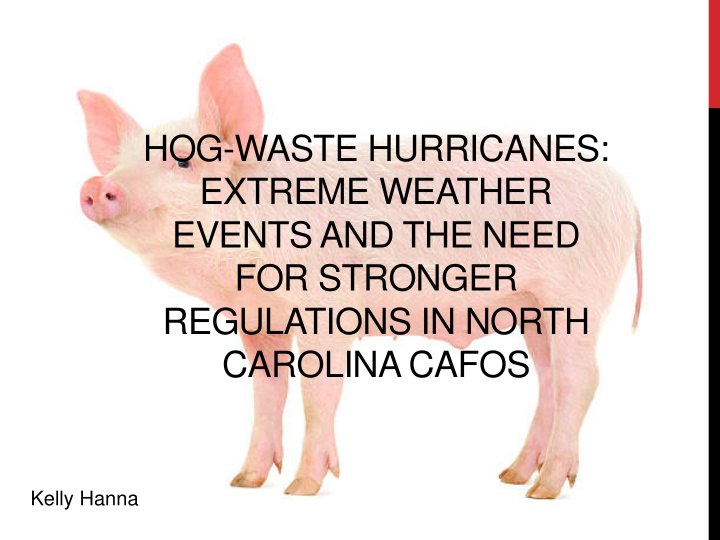



HOG-WASTE HURRICANES: EXTREME WEATHER EVENTS AND THE NEED FOR STRONGER REGULATIONS IN NORTH CAROLINA CAFOS Kelly Hanna
OVERVIEW IA. WHAT ARE CAFOS? ● Qualifications ● CAFOs in North Carolina ● Threats to water security IB. HURRICANES IN NORTH CAROLINA ● Previous destruction ● Recent destruction from Hurricane Florence ● Threat of increased hurricanes thanks to climate change II. CURRENT CAFO REGULATIONS III. PROPOSED REGULATIONS
CAFO: Concentrated Animal Feeding Operation Provide 99% of animal products to Americans Facility housing the following • 2,500 hogs • 1,000 cattle • 700 dairy cows • Or 125,000 chickens
NORTH CAROLINA: CAFOS ARE THE NORM. Second-largest hog-farming industry in the U.S. Generates $3 billion annually To be exact: • With 2,300 hog CAFOs throughout the state, NC has more than 9 million hogs • Almost 4,000 hogs per farm
WHERE DOES ALL OF THE WASTE GO?
Waste-Water Lagoons: A Threat to Water Security NC utilizes over 4,000 lagoons • 170 are located within the state’s 100-year floodplain • 136 are located within a half mile of public water wells 10 billion gallons of wet waste is produced annually
MOST CAFOS FALL WITHIN STATE’S LARGEST RIVER BASIN
What happens to lagoons during flooding? ○ Overtopping and Breaching ○ Contaminants and volatile compounds released when overtopping occurs: ● Phosphorus, ammonia, nitrogen, pathogens, sulfides, methane, hormones, and antibiotics
Studies show that flooding events are going to increase as a consequence of climate change. NOAA predicts a 20% increase of category 3, 4, and 5 storms by the end of the century.
Hurricanes in North Carolina 1950-1979: 79 tropical or subtropical cyclones; 37 deaths; $3 billion worth of damage 1980-2017: 120 tropical or subtropical cyclones; 77 direct casualties; $10 billion worth of damage
Hurricane Florence: a new level of destruction • Category 4 • Over $22 billion in damages thus far • CPF was 25 feet above flood level • Over 110 overtopped lagoons • 2.2 million gallons of waste water released into surrounding ecosystems
15
The Role of Climate Change Increased global temperatures leads to: • Higher evaporation rates • Increased surface water temperature Hurricanes draw energy from atmospheric moisture and surface water. Weakened jet stream changes atmospheric blocking patters, allowing for longer storm duration.
EXISTING REGULATIONS A. 1. Clean Water Act B. 2. Relocation of CAFOs C. 3. Clean Air Act
Clean Water Act (CWA) • Required to receive a permit under NPDES system • Sets standard for TMDL into water bodies • Only for large CAFOs • Broad exemption for storm water runoff Statewide initiative for a program that buys CAFOs and relocates them away from the floodplain
Clean Air Act (CAA) • Regulates major sources of air emissions only • Pushback from the industry has allowed leniency • Agricultural exemption from Title V Combatting air emissions does not necessarily equate to combating lagoons.
PROPOSED REGULATIONS A. 1. Nuisance Cases B. 2. Amend the Clean Water Act C. 3. Incentivize Anaerobic Digesters
● Some nuisance claims regarding spray-fields have seen success ■ McKiver, et al. v. Murphy-Brown LLC ■ Jacobs, et al. v. Murphy-Brown LLC ( $473mil to 500 plaintiffs) Eliminate or amend right-to-farm laws so corporations are not so heavily favored.
Eliminate the storm water exemption in the CWA. • CAFOs could be held liable for damage comparable to municipality liability for sewage backup • Would achieve same nuisance claim success of monetary reward and negative publicity • Could inspire CAFOs to turn to alternative waste disposal…
● State government should incentivize anaerobic digesters for existing facilities and require them in future facilities.
Prevents Eliminates emission of need for 73,000 tons over 14 of methane lagoons annually Accounts for 14 Powers CAFOs over 3,000 and 13,500 homes cows
Thank you!
Recommend
More recommend